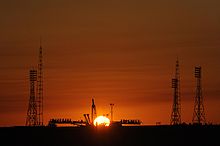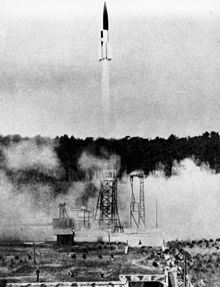Spaceport

| Part ofa serieson |
| Spaceflight |
|---|
 |
|
|
Aspaceportorcosmodromeis a site for launching or receivingspacecraft,by analogy to a seaport for ships or an airport for aircraft. The wordspaceport,and even more socosmodrome,has traditionally been used for sites capable of launchingspacecraft into orbitaround Earth or on interplanetary trajectories.[1]However, rocket launch sites for purelysub-orbital flightsare sometimes called spaceports, as in recent years new and proposed sites for suborbital human flights have been frequently referred to or named "spaceports".Space stationsand proposed future bases on the Moon are sometimes called spaceports, in particular if intended as a base for further journeys.[2]
The termrocket launch siteis used for any facility from which rockets are launched. It may contain one or morelaunch padsor suitable sites to mount a transportable launch pad. It is typically surrounded by a large safety area, often called arocket rangeormissile range.The range includes the area over which launched rockets are expected to fly, and within which some components of the rockets may land. Tracking stations are sometimes located in the range to assess the progress of the launches.[3]
Major spaceports often include more than onelaunch complex,which can be rocket launch sites adapted for different types oflaunch vehicles.(These sites can be well-separated for safety reasons.) For launch vehicles with liquid propellant, suitable storage facilities and, in some cases, production facilities are necessary. On-site processing facilities for solid propellants are also common.
A spaceport may also includerunwaysfor takeoff and landing of aircraft to support spaceport operations, or to enable support ofHTHLor horizontal takeoff and vertical landing (HTVL) winged launch vehicles.
History[edit]

The firstrocketsto reach space wereV-2 rocketslaunched fromPeenemünde,Germanyin 1944 duringWorld War II.[4]After the war, 70 complete V-2 rockets were brought toWhite Sandsfor test launches, with 47 of them reaching altitudes between 100 km and 213 km.[5]
The world's first spaceport for orbital and human launches, theBaikonur Cosmodromein southernKazakhstan,started as a Soviet military rocket range in 1955. It achieved the first orbital flight (Sputnik 1) in October 1957. The exact location of the cosmodrome was initially held secret. Guesses to its location were misdirected by a name in common with a mining town 320 km away. The position became known in 1957 outside the Soviet Union only afterU-2planes had identified the site by following railway lines in theKazakh SSR,although Soviet authorities did not confirm the location for decades.[6]
The Baikonur Cosmodrome achieved the first launch of a human into space (Yuri Gagarin) in 1961. The launch complex used, Site 1, has reached a special symbolic significance and is commonly calledGagarin's Start.Baikonur was the primary Soviet cosmodrome, and is still frequently used by Russia under a lease arrangement with Kazakhstan.
In response to the early Soviet successes, the United States built up a major spaceport complex at Cape Canaveral in Florida. A large number of uncrewed flights, as well as the early human flights, were carried out atCape Canaveral Space Force Station.For the Apollo programme, an adjacent spaceport,Kennedy Space Center,was constructed, and achieved the first crewed mission to the lunar surface (Apollo 11) in July 1969. It was the base for allSpace Shuttlelaunches and most of their runway landings. For details on the launch complexes of the two spaceports, seeList of Cape Canaveral and Merritt Island launch sites.
TheGuiana Space Centrein Kourou, French Guiana, is the major European spaceport, with satellite launches that benefit from the location 5 degrees north of the equator.
In October 2003 theJiuquan Satellite Launch Centerachieved the first Chinese human spaceflight.
Breaking with tradition, in June 2004 on a runway atMojave Air and Space Port,California, a human was for the first time launched to space in aprivatelyfunded, suborbital spaceflight, that was intended to pave the way for future commercial spaceflights. The spacecraft,SpaceShipOne,was launched by a carrier airplane taking off horizontally.
At Cape Canaveral,SpaceXin 2015 made the first successful landing and recovery of a first stage used in a vertical satellite launch.[7]
Location[edit]
Rockets can most easily reach satellite orbits if launched near theequatorin an easterly direction, as this maximizes use of theEarth's rotationalspeed (465 m/s at the equator). Such launches also provide a desirable orientation for arriving at ageostationary orbit.Forpolar orbitsandMolniya orbitsthis does not apply.
In principle, advantages of high altitude launch are reduced vertical distance to travel and a thinner atmosphere for the rocket to penetrate. However, altitude of the launch site is not a driving factor in spaceport placement because most of thedelta-vfor a launch is spent on achieving the required horizontalorbital speed.The small gain from a few kilometers of extra altitude does not usually off-set the logistical costs of ground transport in mountainous terrain.
Many spaceports have been placed at existing military installations, such asintercontinental ballistic missileranges, which are not always physically ideal sites for launch.
A rocket launch site is built as far as possible away from major population centers in order to mitigate risk to bystanders should a rocket experience a catastrophic failure. In many cases a launch site is built close to major bodies of water to ensure that no components are shed over populated areas. Typically a spaceport site is large enough that, should a vehicle explode, it will not endanger human lives or adjacent launch pads.[8]
Planned sites of spaceports forsub-orbitaltourist spaceflight often make use of existing ground infrastructure, including runways. The nature of the local view from 100 km (62 mi) altitude is also a factor to consider.

Space tourism[edit]
Thespace tourismindustry (seeList of private spaceflight companies) is being targeted by spaceports in numerous locations worldwide. e.g.Spaceport America,New Mexico.
The establishment of spaceports for tourist trips raises legal issues, which are only beginning to be addressed.[9][10]
With achieved vertical launches of humans[edit]
The following is a table of spaceports and launch complexes for vertical launchers with documented achieved launches of humans to space (more than 100 km (62 mi) altitude). The sorting order is spaceport by spaceport according to the time of the first human launch.
† Three of the Soyuz missions were uncrewed and are not counted (Soyuz 2,Soyuz 20,Soyuz 34).
‡STS-51-L(Challenger) failed to reach orbit and is not counted.STS-107(Columbia) reached orbit and is therefore included in the count (disaster struck on re-entry).
Crewed Missions failed to reachKármán line:
Soyuz T-10a(1983)
STS-51-L(1986)
Soyuz MS-10(2018)
With achieved satellite launches[edit]
The following is a table of spaceports with a documented achieved launch to orbit. The table is sorted according to the time of the first launch that achieved satellite orbit insertion. The first column gives the geographical location. Operations from a different country are indicated in the fourth column. A launch is counted as one also in cases where the payload consists of multiple satellites.
With achieved horizontal launches of humans to 100 km[edit]
The following table shows spaceports with documented achieved launches of humans to at least 100 km altitude, starting from a horizontal runway. All the flights weresub-orbital.
| Spaceport | Carrier aircraft | Spacecraft | Flights above 100 km | Years |
|---|---|---|---|---|
| B-52 | X-15 | 2 | 1963 | |
| White Knight | SpaceShipOne | 3 | 2004 |
Beyond Earth[edit]
Spaceports have been proposed for locations on theMoon,Mars,orbiting the Earth, at Sun-Earth and Earth-MoonLagrange points,and at other locations in theSolar System.Human-tended outposts on the Moon or Mars, for example, will be spaceports by definition.[32]The 2012 Space Studies Program of theInternational Space Universitystudied the economic benefit of a network of spaceports throughout the solar system beginning from Earth and expanding outwardly in phases, within its team project Operations And Service Infrastructure for Space (OASIS).[33]Its analysis claimed that the first phase, placing the "Node 1" spaceport with space tug services inlow Earth orbit(LEO), would be commercially profitable and reduce transportation costs togeosynchronous orbitby as much as 44% (depending on the launch vehicle). The second phase would add a Node 2 spaceport on the lunar surface to provide services includinglunar icemining and delivery of rocketpropellantsback to Node 1. This would enable lunar surface activities and further reduce transportation costs within and out fromcislunar space.The third phase would add a Node 3 spaceport on the Martian moonPhobosto enable refueling and resupply prior to Mars surface landings, missions beyond Mars, and return trips to Earth. In addition to propellant mining and refueling, the network of spaceports could provide services such as power storage and distribution, in-space assembly and repair of spacecraft, communications relay, shelter, construction and leasing of infrastructure, maintaining spacecraft positioned for future use, and logistics.[34]
See also[edit]
Notes[edit]
References[edit]
- ^Roberts, Thomas G. (2019)."Spaceports of the World".Center for Strategic and International Studies.Archivedfrom the original on 7 August 2020.Retrieved1 July2020.
- ^"Moon as a Spaceport - NASA's Mars Forum - by IdeaScale".Archived fromthe originalon 24 December 2014.
- ^Merritt Island Spaceflight Tracking and Data Network station
- ^Dyson, Marianne J. (2007).Space and astronomy: decade by decade.Infobase Publishing. p. 95.ISBN978-0-8160-5536-4.
- ^Ernst Stuhlinger, Enabling technology for space transportation (The Century of Space Science, page 66, Kluwer,ISBN0-7923-7196-8)
- ^"Baikonur Cosmodrome (NIIP-5/GIK-5)".russianspaceweb.Archivedfrom the original on 8 February 2003.Retrieved24 December2010.
- ^Grush, Loren (21 December 2015)."SpaceX successfully landed its Falcon 9 rocket after launching it to space".The Verge.Archivedfrom the original on 28 June 2017.Retrieved9 April2016.
- ^"Overlookpress".overlookpress.Archived fromthe originalon 13 January 2018.
- ^Londin, Jesse (9 February 2007)."Space Law Probe: Virginia Leads The Way".blogspot.Archivedfrom the original on 22 August 2017.Retrieved28 April2007.
- ^Boyle, Alan (13 June 2006)."Regulators OK Oklahoma spaceport - Suborbital test flights could begin in 2007, setting stage for tourists".NBC News.Archivedfrom the original on 30 April 2013.Retrieved26 June2006.
- ^"Baikonur".astronautix.Archived fromthe originalon 7 February 2002.
- ^"Vandenberg".astronautix.Archived fromthe originalon 8 February 2002.
- ^Howell, Elizabeth (22 September 2016)."Vandenberg: West Coast Launch Site".Space.Archivedfrom the original on 15 June 2018.Retrieved1 October2021.
- ^abcdefghijkl"Wallops Island".astronautix.Archivedfrom the original on 3 March 2022.Retrieved23 April2022.
- ^ab"Kapustin Yar".astronautix.Archived fromthe originalon 4 November 2007.
- ^"Hammaguira".astronautix.Archived fromthe originalon 5 May 2002.
- ^ab"Plesetsk".astronautix.Archived fromthe originalon 29 December 2007.
- ^"Arianespace - Launch program activity".Archivedfrom the original on 9 February 2014.Retrieved26 May2009.
- ^"Xichang".astronautix.Archived fromthe originalon 29 January 2005.
- ^"Taiyuan".astronautix.Archived fromthe originalon 28 December 2016.
- ^ab"Svobodniy".astronautix.Archived fromthe originalon 2 August 2002.
- ^"Kodiak".astronautix.Archived fromthe originalon 7 July 2009.
- ^ Kodiak Readies for Quick Launch,Aviation Week,April 2010, accessed 26 April 2010. "Alaska's remote Kodiak Launch Complex is state-of-the-art, has a perfect mission record, and will soon be able to launch a satellite-carrying rocket within 24 hours of mission go-ahead."
- ^"Dombarovskiy".astronautix.Archived fromthe originalon 18 June 2008.
- ^"Welcome to Virginia Space".vaspace.org.Archivedfrom the original on 14 August 2021.Retrieved1 October2021.
- ^"Imam Khomeini Space Center | Facilities".NTI.Archivedfrom the original on 5 July 2017.Retrieved30 November2017.
- ^"North Korea says it successfully launched controversial satellite into orbit".MSNBC.12 December 2012. Archived fromthe originalon 13 December 2012.
- ^"news.xinhuanet".Archived fromthe originalon 4 February 2013.
- ^"Iran's first space launch center near Shahrud for its Ghaem SLV project".b14643.de.Retrieved6 June2022.
- ^Hinz, Fabian."IRAN'S SOLID-PROPELLANT SLV PROGRAM IS ALIVE AND KICKING".
- ^[Mendell, Wendell W. (1985).Lunar bases and space activities of the 21st century.Lunar and Planetary Institute.ISBN0-942862-02-3.]
- ^http:// oasisnext /Archived24 December 2014 at theWayback Machine,OASIS official website
- ^"OASIS Executive Summary Operations And Service Infrastructure for Space".Archivedfrom the original on 25 January 2014.Retrieved7 December2012.
External links[edit]
 Media related toSpaceportsat Wikimedia Commons
Media related toSpaceportsat Wikimedia Commons The dictionary definition ofspaceportat Wiktionary
The dictionary definition ofspaceportat Wiktionary- U.S. Spaceports Online Reference Guide
- Center for Strategic and International Studies:Spaceports of the World
- Sheboygan Spaceport’s Future – Sea to Space
- HighBeam Research:Spaceflight of fancy: Lawmakers question fiscal feasibility of Southern New Mexico's proposed spaceport; supporters count on jobs.Archived25 January 2013 atarchive.today
- Spaceport Earth: The Reinvention of SpaceflightSpaceport Earth: The Reinvention of Spaceflight - categories | Overlook Press
